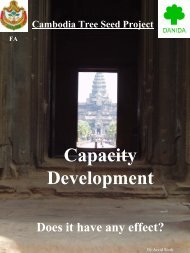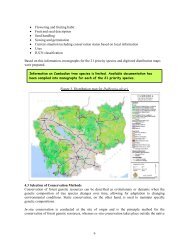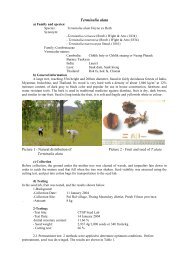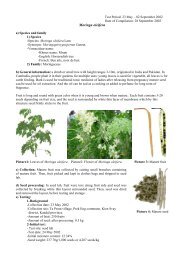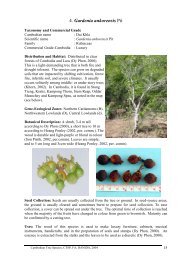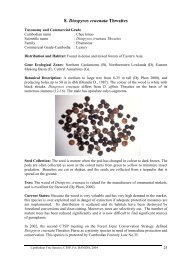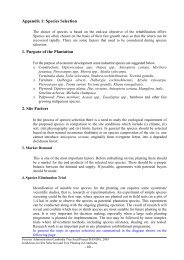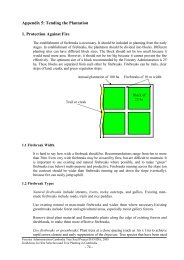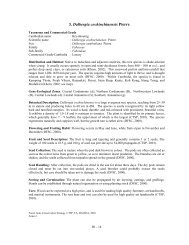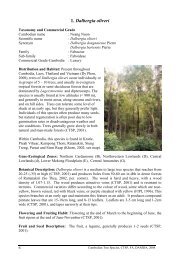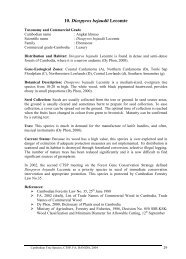Introduction - Cambodia Tree Seed Project
Introduction - Cambodia Tree Seed Project
Introduction - Cambodia Tree Seed Project
You also want an ePaper? Increase the reach of your titles
YUMPU automatically turns print PDFs into web optimized ePapers that Google loves.
A. FLORA OF CAMBODIA<br />
1. <strong>Introduction</strong><br />
In the Indochina Region, a number of tree species are vulnerable to extinction at the<br />
species and population levels. It is also recognized that the maintenance of forest genetic<br />
resources is essential to sustainable development. Thus various countries are endeavouring to<br />
conserve the genetic diversity of useful and economically important tree species that are<br />
native to the region.<br />
The first list of 21 priority tree species for gene conservation in <strong>Cambodia</strong> was<br />
established during the Second Forest Gene Conservation Meeting on January 29, 2002,<br />
organised by <strong>Cambodia</strong> <strong>Tree</strong> <strong>Seed</strong> <strong>Project</strong>. The identification and selection of priority tree<br />
species was based on the value of present and future uses of various plants, their relevance to<br />
contemporary tree planting programmes and subsistence economies, as well as their<br />
conservation status.<br />
The aim of this paper is to provide a descriptive profile of selected priority species<br />
regarding their natural history, ecological requirements, natural distributions, present-day<br />
distributions, uses, genetic characteristics, vulnerabilities, and conservation status.<br />
2. Botanical Work in <strong>Cambodia</strong><br />
Generally speaking, botanical work in <strong>Cambodia</strong> has been very limited. Until<br />
recently, our understanding of the country's flora and vegetation reflected the ad hoc<br />
activities of a small number of botanists and foresters. Most of these authors have studied a<br />
limited number of vegetation types, sites, or ethnobotanical aspects of Khmer culture, and<br />
most of these works were produced before the political and economic implosion of <strong>Cambodia</strong><br />
in the 1970s.<br />
Investigations in <strong>Cambodia</strong> and other parts of French Indochina commenced in the<br />
latter part of the nineteenth century, leading to the publication of seven volumes of the<br />
definitive Flore Generale de l'Indochine (Lecompte 1907-1942). These volumes describe<br />
over 8,000 species from <strong>Cambodia</strong>, Laos, and Vietnam. Supplementary volumes commenced<br />
in 1964, with the publication of the Flore du Camboge, Laos et Vietnam. By 1994, 27<br />
volumes addressing 71 of the 164 families were published.<br />
Dy Phon (1981, 1982) indicates that <strong>Cambodia</strong> possesses 2,308 of the 8,000 species<br />
described in the Flore Generale de l'Indochine. These 2,308 species belong to 852 genera in<br />
164 families, and include:<br />
Gymnosperms: 7 genera 14 species<br />
Monocotyledons: 219 genera 488 species<br />
Dicotyledons: 626 genera 1,806 species<br />
Taxonomic revisions that have been published over the last few decades suggest that<br />
many more species will certainly be discovered. Current estimates place the total number of<br />
plant species in <strong>Cambodia</strong>, Laos and Vietnam from 12,000-15,000 (IUCN, 1995). The full<br />
<strong>Cambodia</strong>n <strong>Tree</strong> Species, CTSP, FA, DANIDA, 2004 1
list for <strong>Cambodia</strong> is expected to exceed 3,000 species (Dy Phon, 2002, pers. comm.), with<br />
expectations that at least 700 additional species will be described as new to science in the<br />
country. It may be assumed that a minimum of ten percent of these species will be endemic<br />
to the country. The World Conservation Monitoring Centre 2000 estimates 8260 plant<br />
species in <strong>Cambodia</strong>, 10% endemic of which will be endemic. There is, therefore, still<br />
considerable scope for further documentation of the flora of Indochina. This is thought to be<br />
particularly true for <strong>Cambodia</strong>, which has never undertaken a systematic, national inventory<br />
of its flora.<br />
Dy Phon (1970, 1971) provides the only systematic vegetation survey that considers<br />
all vascular flora of an area. Her treatise of the flora and vegetation of the Bay of Kampong<br />
Som, Phnom Bokor of the Elephant Mountains, and the Kirirum plateau, as well as Ashton's<br />
(1964) brief descriptions of the coastal hinterlands of the Cardamom Mountains, represent the<br />
more substantial botanical works in <strong>Cambodia</strong>.<br />
Dy Phon's work has been complemented by a range of forest inventories and surveys<br />
of medicinal and other useful plants (eg. Ashton 1964; Eav Bov Bang 1970; FAO 1970;<br />
Martin 1973, 1997; and Rollet 1962, 1972a, 1972b and 1972c). Forest inventories were not<br />
accompanied by assessments of the full range of plant resources, and no naturalist has ever<br />
described forest areas over 1,100 meters elevation in <strong>Cambodia</strong>. Rollet (1972c) provides,<br />
however, a preliminary listing of some common genera at higher altitudes. Legris and Blasco<br />
(1971, 1972) and Dy Phon (1981) have synthesise much of this information to provide a<br />
national overview of <strong>Cambodia</strong>'s vegetation types and their principle species. More recently,<br />
McDonald et al. (1997) conducted a detailed survey of the flora of the Tonle Sap floodplain,<br />
and in 1998, FAO undertook the establishment of a forest inventory process with MAFF/FA.<br />
From 1998 to the present, the FA, in cooperation with international environmental NGOs<br />
such as FFI, ARA, CAT, WCS, WWF, and CI, have conducted conservation surveys. The<br />
result of these activities has led to some updates to the <strong>Cambodia</strong>n check list of especially<br />
fauna, and to lesser extent of flora. They have also established three new protected zones in<br />
the Cardamom Mountain region.<br />
<strong>Cambodia</strong>n forests are dominated by species of Dipterocarpaceae, Leguminosae,<br />
Lythraceae, or Fagaceae, and in some places Pinaceae, Podocarpaceae, or bamboo. Lowland<br />
floras of <strong>Cambodia</strong> are typical of the Indochinese Floristic Province (and as such, contrasts<br />
with that of Chinese, Indo-Burmese, and Indo-Malayan Biogeographical Provinces), whilst<br />
the highland floras share a closer affinity with those of the Indo-Malayan region (Dy Phon<br />
1982).<br />
Legris and Blasco's (1972) vegetation map remains the most ecologically sensible<br />
map for <strong>Cambodia</strong>n forests, even though considerable deforestation and degradation has<br />
occurred since the time of their study. This earlier map has recently been reviewed, and is<br />
commercially available through the French company ECOCART, though not yet available in<br />
<strong>Cambodia</strong>.<br />
Whilst in recent times botanical research has increased, many species are yet to be<br />
documented. In view of the rapid depletion of the forest resources, such work is of great<br />
importance in order to identify useful species before they are lost. Such information will lead<br />
to the identification of appropriate options for different forest management systems.<br />
High market prices and demands for commercial trees are leading to the extinction of<br />
rare and endangered species in <strong>Cambodia</strong>. As forest resources continue to be depleted,<br />
2<br />
<strong>Cambodia</strong>n <strong>Tree</strong> Species, CTSP, FA, DANIDA, 2004
indigenous seed sources are also degraded, thereby reducing potentials of forest regeneration<br />
in <strong>Cambodia</strong>. In order to begin to address this issue, 21 tree species have been selected for<br />
gene conservation. Gaps in our current knowledge of priority species are evident in this<br />
document; and in addition, botanical studies indicate that many species within the country<br />
have not been documented.<br />
Human and financial resources remain very limited within the country, but it is<br />
important to strengthen capacity for gene conservation and reforestation activities in order to<br />
better manage and conserve priority species and sustain the natural resource base. Without<br />
such measures, future generations may not have the chance to benefit from these species.<br />
<strong>Cambodia</strong>n <strong>Tree</strong> Species, CTSP, FA, DANIDA, 2004 3
BIBLIOGRAPHY<br />
Ashton, P.S., 1964, Inventaire Forestier des Terres Basses du versant Occidental des Monts<br />
Cardamoms, Cambodge.: L'Ecologie Sylivicole el la Botanique Forestiere.<br />
UNDP/FAO FO:SF/CAM 6/ Rapport Technique 5.<br />
Dy Phon, P., 1970, La Végétation du Sud-ouest du Cambodge: Secteur Baie de Kampong<br />
Som, Chaine de l'Elephant et Plateau de Kirirum. Ann. Fac. Sc. Phnom Penh<br />
No. 3: 1-136.<br />
Dy Phon, P., 1971, La Végétation du Sud-ouest du Cambodge: Secteur Baie de Kampong<br />
Som, Chaine de l'Elephant et Plateau de Kirirum. Ann. Fac. Ac. Phnom Penh<br />
No. 4. pp 1-77 .<br />
Dy Phon, P., 1981, Contribution a l'Etude de la Vegetation du Cambodge. Ph.D Thesis,<br />
Universite de Paris –Sud, Centre d'Orsay, Paris.<br />
Dy Phon, P., 1982, Végétation du Cambodge: endemisme et affinités de sa flore avec les<br />
région voisines, C.R. Séances Soc. Biogéogr, 58 (3): 135-144.<br />
Dy Phon, 2000, Dictionary of Plants used in <strong>Cambodia</strong>.<br />
Eav Bov Bang, 1970, Contribution a l'Etude de l'Amenagement de la Reserve des Phnoms<br />
Koulen et de Kohker. Mémoire de Fin d'Etudes, Universite des Science<br />
Agronomiques, Faculte des science Forestrieres, Phnom Penh.<br />
FAO, 1970, Forest Survey of the Lowlands West of the Cardamom Mountains, <strong>Cambodia</strong>.<br />
Final Report. UNDP/ FAO. FAO/ SF. 91/ CAM6.<br />
IUCN, 1995,<br />
Centres of Plant Diversity, Volume 2 –Australia, Asia and the Pacific,<br />
IUCN- The World Conservation Union.<br />
Lecompte, H., 1907-1942, Flore General de l'Indochine, Vols 1-9, Paris.<br />
Legris, P. and Blasco, F., 1971, Carté International du Tapis Végétal et des Conditions<br />
Écologiques au Cambodge, 1/1,000,000. Trav. Sect. Scient. Techn. Inst. Fr.<br />
Pondichéry, Hors sér. 11: 1-238<br />
Legris, P. and Blasco, F., 1972, La Végétation Naturelle, in "Notice de la Carte du<br />
Cambodge". (Carté International du Tapis Végétal et des Conditions<br />
Écologiques au Cambodge, 1/1,000,000.) Trav. Sect. Scient. Techn. Inst. Fr.<br />
Pondichéry, Hors sér. 11: 1-238<br />
Martin, M.A., 1973, Notes on the Vegetation of the Cardamom Mountains, <strong>Cambodia</strong>, in<br />
Garden's Bulletin XXVI (II): 213-222, Centre National de la Recherche<br />
Scientifique de Paris.<br />
McDonald, J.A., 1997, Flora and Vegetation Types of the Bokor Plateau: Its Significance to<br />
Conservation Initiatives in the Elephant Mountains, SPEC (Support Program<br />
to the Environmental Sector in <strong>Cambodia</strong>), European Commission, Phnom<br />
Penh, <strong>Cambodia</strong>.<br />
Rollét, B., 1962, Inventaire Forestiere de l'Est Mékong, Rapport au Gouvernement<br />
Cambodge. Program Élargi d'Assistance Technique FAO No.1500, FAO,<br />
Rome.<br />
Rollét, B., 1972a, La Végétation du Cambodge, Bois Foréts des Tropiques, No. 144.<br />
Rollét, B., 1972b, La Végétation du Cambodge, Bois Foréts des Tropiques, No. 145.<br />
Rollét, B., 1972c, La Végétation du Cambodge, Bois Foréts des Tropiques, No. 146.<br />
4<br />
<strong>Cambodia</strong>n <strong>Tree</strong> Species, CTSP, FA, DANIDA, 2004



